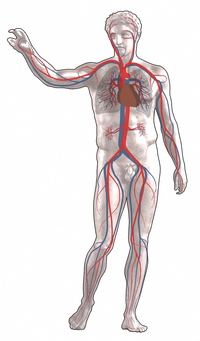
Photo from wikipedia
Quantitative functional magnetic resonance imaging methods make it possible to measure cerebral oxygen metabolism (CMRO2) in the human brain. Current methods require the subject to breathe special gas mixtures (hypercapnia… Click to show full abstract
Quantitative functional magnetic resonance imaging methods make it possible to measure cerebral oxygen metabolism (CMRO2) in the human brain. Current methods require the subject to breathe special gas mixtures (hypercapnia and hyperoxia). We tested a noninvasive suite of methods to measure absolute CMRO2 in both baseline and dynamic activation states without the use of special gases: arterial spin labeling (ASL) to measure baseline and activation cerebral blood flow (CBF), with concurrent measurement of the blood oxygenation level dependent (BOLD) signal as a dynamic change in tissue R2*; VSEAN to estimate baseline O2 extraction fraction (OEF) from a measurement of venous blood R2, which in combination with the baseline CBF measurement yields an estimate of baseline CMRO2; and FLAIR-GESSE to measure tissue R2' to estimate the scaling parameter needed for calculating the change in CMRO2 in response to a stimulus with the calibrated BOLD method. Here we describe results for a study sample of 17 subjects (8 female, mean age = 25.3 years, range 21-31 years). The primary findings were that OEF values measured with the VSEAN method were in good agreement with previous PET findings, while estimates of the dynamic change in CMRO2 in response to a visual stimulus were in good agreement between the traditional hypercapnia calibration and calibration based on R2'. These results support the potential of gas-free methods for quantitative physiological measurements.
Journal Title: NeuroImage
Year Published: 2020
Link to full text (if available)
Share on Social Media: Sign Up to like & get
recommendations!